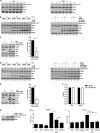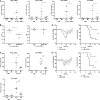Inhibition of p38 mitogen-activated protein kinase impairs influenza virus-induced primary and secondary host gene responses and protects mice from lethal H5N1 infection
- PMID: 24189062
- PMCID: PMC3879537
- DOI: 10.1074/jbc.M113.469239
Inhibition of p38 mitogen-activated protein kinase impairs influenza virus-induced primary and secondary host gene responses and protects mice from lethal H5N1 infection
Abstract
Highly pathogenic avian influenza viruses (HPAIV) induce severe inflammation in poultry and men. One characteristic of HPAIV infections is the induction of a cytokine burst that strongly contributes to viral pathogenicity. This cell-intrinsic hypercytokinemia seems to involve hyperinduction of p38 mitogen-activated protein kinase. Here we investigate the role of p38 MAPK signaling in the antiviral response against HPAIV in mice as well as in human endothelial cells, the latter being a primary source of cytokines during systemic infections. Global gene expression profiling of HPAIV-infected endothelial cells in the presence of the p38-specific inhibitor SB 202190 revealed that inhibition of p38 MAPK leads to reduced expression of IFNβ and other cytokines after H5N1 and H7N7 infection. More than 90% of all virus-induced genes were either partially or fully dependent on p38 signaling. Moreover, promoter analysis confirmed a direct impact of p38 on the IFNβ promoter activity. Furthermore, upon treatment with IFN or conditioned media from HPAIV-infected cells, p38 controls interferon-stimulated gene expression by coregulating STAT1 by phosphorylation at serine 727. In vivo inhibition of p38 MAPK greatly diminishes virus-induced cytokine expression concomitant with reduced viral titers, thereby protecting mice from lethal infection. These observations show that p38 MAPK acts on two levels of the antiviral IFN response. Initially the kinase regulates IFN induction and, at a later stage, p38 controls IFN signaling and thereby expression of IFN-stimulated genes. Thus, inhibition of MAP kinase p38 may be an antiviral strategy that protects mice from lethal influenza by suppressing excessive cytokine expression.
Keywords: Endothelium; Highly Pathogenic Avian Influenza Virus (HPAIV); Hypercytokinemia; Influenza Virus; Interferon; JAK/STAT Signaling; STAT Transcription Factor; p38 MAPK.
Figures







References
-
- Cillóniz C., Shinya K., Peng X., Korth M. J., Proll S. C., Aicher L. D., Carter V. S., Chang J. H., Kobasa D., Feldmann F., Strong J. E., Feldmann H., Kawaoka Y., Katze M. G. (2009) Lethal influenza virus infection in macaques is associated with early dysregulation of inflammatory related genes. PLoS Pathog. 5, e1000604. - PMC - PubMed
-
- de Jong M. D., Simmons C. P., Thanh T. T., Hien V. M., Smith G. J., Chau T. N., Hoang D. M., Chau N. V., Khanh T. H., Dong V. C., Qui P. T., Cam B. V., Ha do Q., Guan Y., Peiris J. S., Chinh N. T., Hien T. T., Farrar J. (2006) Fatal outcome of human influenza A (H5N1) is associated with high viral load and hypercytokinemia. Nat. Med. 12, 1203–1207 - PMC - PubMed
-
- Tran T. H., Nguyen T. L., Nguyen T. D., Luong T. S., Pham P. M., Nguyen vV., Pham T. S., Vo C. D., Le T. Q., Ngo T. T., Dao B. K., Le P. P., Nguyen T. T., Hoang T. L., Cao V. T., Le T. G., Nguyen D. T., Le H. N., Nguyen K. T., Le H. S., Le V. T., Christiane D., Tran T. T., Menno de J., Schultsz C., Cheng P., Lim W., Horby P., Farrar J., and World Health Organization International Avian Influenza Investigative Team (2004) Avian influenza A (H5N1) in 10 patients in Vietnam. N. Engl. J. Med. 350, 1179–1188 - PubMed
-
- Klenk H. D. (2005) Infection of the endothelium by influenza viruses. Thromb. Haemost. 94, 262–265 - PubMed
Publication types
MeSH terms
Substances
Associated data
- Actions
LinkOut - more resources
Full Text Sources
Other Literature Sources
Medical
Molecular Biology Databases
Research Materials
Miscellaneous

